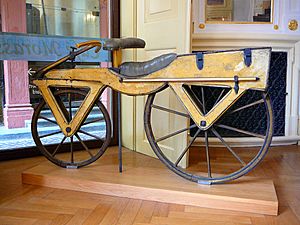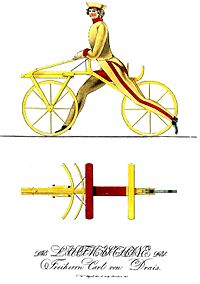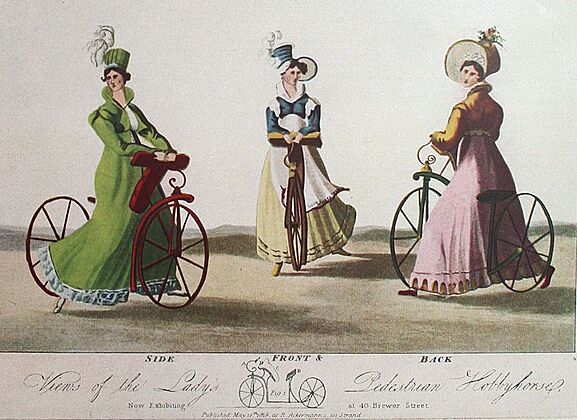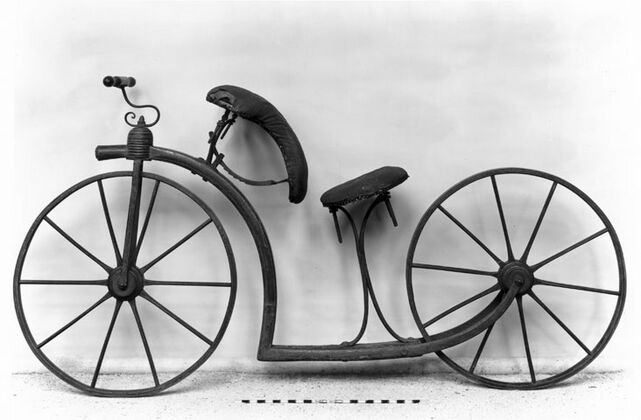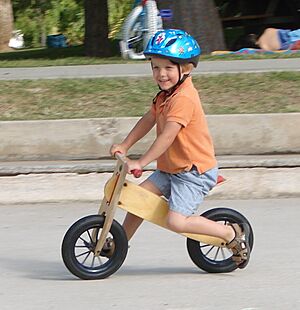Dandy horse facts for kids
The dandy horse was one of the first vehicles to use two wheels. It is seen as the ancestor of the modern bicycle. People also called it a Laufmaschine (which means "running machine" in German), a vélocipède, or a draisienne.
Unlike today's bicycles, the dandy horse had no pedals. Riders moved it by pushing their feet along the ground. Karl Drais invented it in 1817. He called it a Laufmaschine. In 1818, he got a patent for it in France, using the name vélocipède.
Contents
How the Dandy Horse Changed Travel
The dandy horse had two wheels, one behind the other. You steered it using handlebars connected to the front wheel. Riders pushed off the ground with their feet, just like walking or running. This simple machine could more than double a person's walking speed. On flat ground, it could go about 10 miles per hour (16 km/h).
Why Was It Invented?
Karl Drais created the dandy horse because people needed new ways to travel. This was especially true after the eruption of Mount Tambora in 1815. This volcano caused a "Year Without a Summer" in 1816. Crops failed, and there wasn't enough food. Many horses died from starvation or were killed for food.
Drais saw a need for transport that didn't rely on horses. He thought these new machines could be very helpful. They could carry messages or help move injured people, especially when horses were scarce.
-
The only remaining Johnson’s Ladies’ Walking Machine. It is in the Science Museum, London.
Its Short Popularity
The dandy horse became quite popular for a short time in 1819. Many companies in France and England started making their own versions. One famous maker was Denis Johnson in London. He made dandy horses with stylish, curved wooden frames. These frames allowed for bigger wheels.
In the United States, W.K. Clarkson received a patent for a similar two-wheeled vehicle in 1819. However, the original drawings were lost in a fire in 1836. No working model of his invention was ever built.
Challenges and Improvements
When dandy horses first appeared in Mannheim, Germany, around 1820, they were heavy. Riders found them easier to use on smooth sidewalks than on rough roads. This caused problems with people walking. So, many cities around the world banned them from sidewalks. New York City, for example, made a law against using dandy horses in public places.
Early dandy horses had to be custom-made for each rider. This meant they had to match the rider's height and how long their legs were. Later designs improved this. For example, Nicéphore Niépce's 1818 model had a saddle that could be adjusted.
From Dandy Horse to Bicycle
The dandy horse was an important step towards the modern bicycle. In the 1860s in France, people added rotating cranks and pedals to the front wheel of a dandy horse. This created the first vélocipède bicycle as we know it.
Modern Uses of the Dandy Horse Idea
The idea of the dandy horse is still used today. It has been adapted into what we call a balance bike or run bike for children. These bikes help kids learn to balance before they move on to a pedal bicycle.
See also
- Balance bike
- Outline of cycling
- Velocipede


